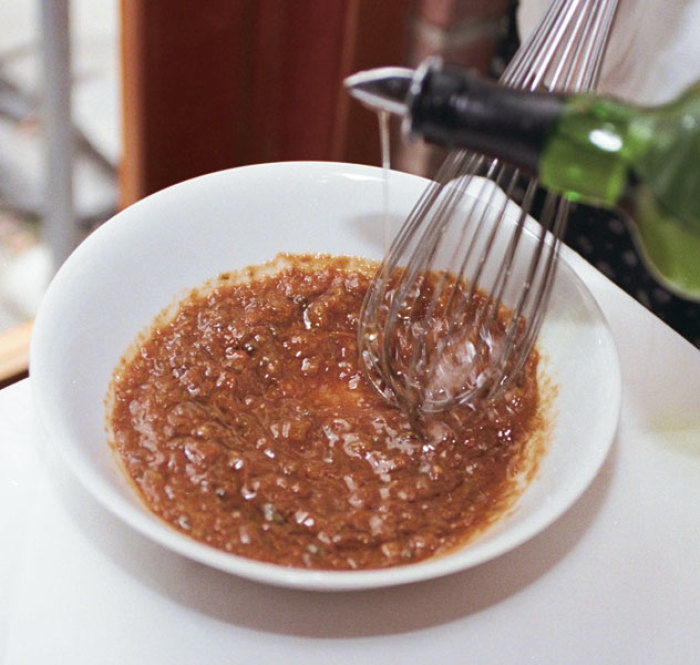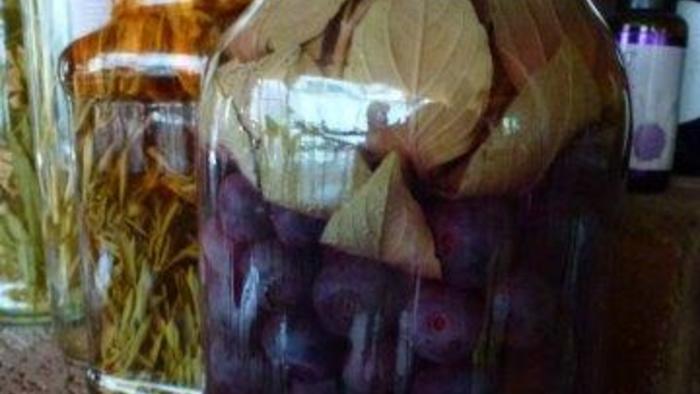
by Diane Forley
June 1997
from issue #9
At its simplest, a vinaigrette is no more than oil, vinegar, and pinches of salt and pepper. But a really good vinaigrette can be much, much more than a simple concoction you pour over salad greens. It can play the role of a sauce in appetizers, entrées, even desserts. Vinaigrettes can be used with vegetables, fruit, pasta, fish, and meat.
The classic vinaigrette is a mixture of oil and vinegar. These two ingredients have a symbiotic relationship. Oil forms a viscous coating that allows the acidic flavor of the vinegar to be distributed evenly. Without the oil, the vinegar would slide to the bottom of the plate. Without the vinegar, the oil could taste flat.
A repertoire of vinegars
There are several ways to put a spin on the classic vinaigrette. First of all, you can expand your choice of vinegars. The ones I use most often are red wine, white wine, champagne, sherry, and balsamic. They each have distinctive properties.
Wine vinegar has a venerable history and is widely used. Its flavor is full of fruit and typically rich, reflecting the grapes it’s made from. Because its taste is generally robust, red-wine vinegar is best used with assertive foods (Red Wine Vinaigrette). In comparison, white wine and champagne vinegars are lighter and enhance delicate flavors. Champagne vinegar works especially well for infusions and vegetable marinades.
Sherry vinegar is sweeter and more complex than other wine vinegars. Use it on substantial salads, especially those with meat, poultry, cheese, and fruit. It’s excellent blended with nut oils. Balsamic vinegar is wildly popular now, and for good reason. Dark, pungent, both sweet and tart, balsamic vinegar can be savored on its own, without oil or other additions.
Take your vinegars a step further by adding flavors through infusion or intensifying them through reduction. Infusion involves steeping a flavorful ingredient, such as an herb, in a heated liquid. The most common way to make an infusion is by steeping one or more ingredients in a light-bodied red-wine or champagne vinegar, then straining the liquid. Candidates for steeping include vegetables, onions, shallots, and herbs. To steep, add the combination of your choice to the vinegar and heat without boiling for 10 minutes.
Reducing a vinegar requires boiling it until the volume is reduced by evaporation. The result is thickened consistency and intensified flavor. Simmering down vinegar softens its raw edge and results in a syrup with a sweet and sour taste, heightened flavor, and added viscosity. You can reduce a vinegar by half or more, depending on the intensity and consistency you want. You’ll find that the high sugar content in sherry and balsamic vinegars makes them particularly good candidates for reduction.
A new cast of oils
Making your own flavored oils opens up a whole realm of new tastes. If you’re going to flavor oil, it’s best to use one with a neutral taste like grape seed or a light-bodied olive oil to avoid competing flavors. Flavored oils can be used in lieu of adding the seasoning directly to a dish. For example, Chile Oil adds a distinctive spiciness to food.
Firm herbs such as rosemary, and flavor enhancers like peppercorns and garlic cloves can be infused into oil. To do this, heat whole herbs in the oil just until hot, then remove from the stove and allow to sit for an hour. Cool and strain through a fine sieve. Freshly chopped herbs can also be added to hot oil. They do not need to be strained out. Flavored oils can be stored for up to a week.
You can also make herb and oil blends. Cook soft herbs like basil, tarragon, and chives in boiling water for about 30 seconds, or until they turn bright green, then shock them in ice water, drain, and place in a blender. Add a slow, steady stream of oil to blend the herbs. You’ll need approximately 1⁄2 cup oil per 2 tablespoons herb purée. This herb and oil blend can now be swirled into a vinaigrette to boost flavor.
Another variation is to use just oil. A fine-quality, extra-virgin olive oil can, on its own, enhance a simple vegetable salad. When distinctive oils, such as nut oils, pumpkin seed oil, or some varieties of olive oil are used alone, the flavor of the oil stands out. Strong-tasting greens like frisée or endive work well with nut oils. Assertive vegetables like artichokes and roasted peppers, as well as fish and seafood, are delicious with a good, fruity olive oil. Eggplant, which absorbs flavors like a sponge, is also complemented by a fruity olive oil.
Vegetable scraps and stocks intensify flavor
Vegetable purées add body and clean vegetable flavor to vinaigrettes. And the purée’s viscosity helps create a stronger emulsion. Because of the saucelike consistency of this type of vinaigrette, it’s great with fish, pasta, and meat entrées. Vegetable scraps are perfect for purées. Red pepper tops, asparagus bottoms, tomato seeds, and cucumber centers have lots of flavor. They can be puréed raw or blanched, and blended with grape seed oil, tasting as you go to correct the seasoning, then passed through a fine-mesh strainer. The purée will keep for several days in the refrigerator. Use it as you would mustard, about 2 teaspoons per cup of vinaigrette.
Vegetable stocks both stabilize and intensify flavors. A vinaigrette with added stock can be used cold as a dressing over salads or warm as an accompaniment to fish, meat, or vegetables. To use a vegetable stock for vinaigrette, reduce the stock by half. For 1 cup of vinaigrette, combine 1⁄6 cup stock and 1⁄6 cup vinegar, and whisk in 2⁄3 cup oil.
Sweet and sour additions
The inherent sweetness of fruits and vegetables can be a great asset in balancing the acidity of some vinaigrettes. Fruits, vegetables, and herbs can be combined in a vinaigrette recipe in the form of reduced vegetable broths, purées, and fruit juices (Roasted Orange Vinaigrette). Remember that an acidic juice will replace some of the acid called for in a vinaigrette.
Similarly, mustard is a sour ingredient, so if you use it, you’ll need less acid, or the acid must be counterbalanced. The best way to tell whether the components of a vinaigrette work together is by tasting them.
Test a vinaigrette’s consistency, as well. The thickness should depend on the vinaigrette’s use. For example, if you are making a vinaigrette for a green salad, dip a leaf into the vinaigrette. It should adhere to the lettuce at first, then gently drip off.
Experimenting can lead to great discoveries of new flavors, and combinations from the garden are endless. Use personalized oils and vinegars in classic proportions to create innovative vinaigrettes. Remember to trust your taste buds, and adjust the seasonings to suit yourself.
Fine Gardening Recommended Products

A.M. Leonard Deluxe Soil Knife & Leather Sheath Combo
Fine Gardening receives a commission for items purchased through links on this site, including Amazon Associates and other affiliate advertising programs.


















Comments
Log in or create an account to post a comment.
Sign up Log in